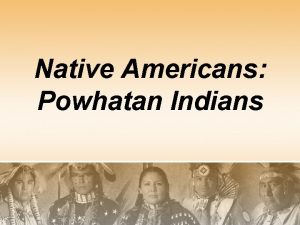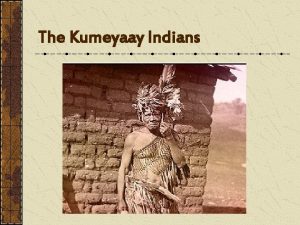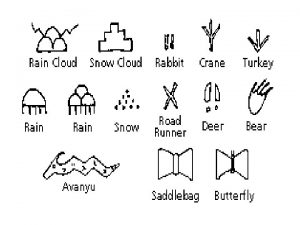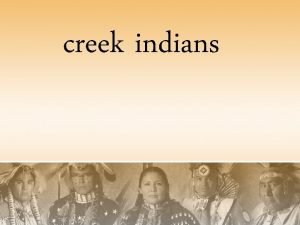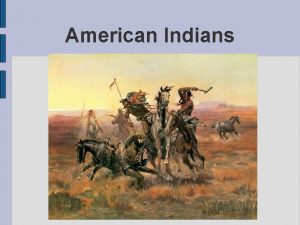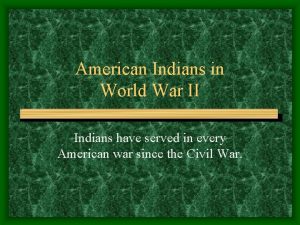Why did the Indians lose the struggle for




















- Slides: 20

Why did the Indians lose the struggle for the Plains?

1. Treaties and wars

CONFLICT BETWEEN WHITES AND INDIANS WAS PARTLY BECAUSE THEY DID NOT UNDERSTAND EACH OTHER.

Robert Mc. Gee was scalped by a Sioux chief in 1864 – the photo was taken in 1890. When the incident happened, Mc. Gee was transporting supplies to a US army fort. 1. Write a headline to accompany this picture in an eastern newspaper. 2. Write a short explanation of the incident by Chief Little Turtle who committed this act.

There were two main views of how to solve ‘the Indian problem’… • NEGOTIATORS wanted • EXTERMINATORS to reach agreement believed the Indians were with the Indians. This savages and best dealt was the feeling of many with by the Army. This politicians in the East. was the view of many such as homesteaders, ranchers and soldiers. Why the difference?

The Permanent Indian Frontier • By 1840 all Indians had been moved beyond a ‘line’, which was known as The Permanent Indian Frontier. This really meant they had the whole of the Great Plains as a kind of vast ‘reservation’. • Why did this not last?

Cycle of conflict INDIANS SIGN PEACE TREATY ARMY DEFEAT INDIANS ARMY CALLED IN TO PROTECT SETTLERS ETC. SETTLERS, MINERS, RAILROAD COMPANIES BREAK TREATY INDIANS ATTACK SETTLERS ETC.

Battle of Little Bighorn 1876 Fort Laramie Treaty 1868 Fort Laramie Treaty 1851 Fort Wise Treaty 1861 Little Crow’s War 1862 Conflict The Indian Wars Medicine Creek Treaty 1867 Cheyenne Uprising 1863 Fetterman’s Trap 1866 Red Cloud’s War 1865 -68 Sand Creek Massacre 1864

Fort Laramie Treaty 1851 Fort Wise Treaty 1861 • Government Aim • Government promise • Indian promise • Government Aim • Government Promise • Indian agreement

Fort Laramie Treaty 1851 Government wanted to stop Indians (Cheyenne & Arapaho) attacking wagon trains on the Oregon Trail. Government Promised: ØLand along foothills of Rocky Mountains would be Indians’ forever. Ø$50, 000 a year for 10 years. Indians promised: ØStop attacking wagon trains. ØAllow building of roads and military posts (forts)

In Rockies Fort Wise Treaty 1861 Government wanted to stop Indians attacking rail surveyors & travellers & give up their land along the Rockies. Government Promised: ØA small reservation between the Arkansas River& Sand Creek. Indian Chiefs: ØAgreed terms. ØBUT could not force their people to do so.

The main clashes 1860 -1876


Little Crow’s war – Santee Sioux • 1861 -1862 • At start of reservation system. • Poor harvest followed by no payment from govt. led to 12, 000 facing starvation. • Settlers, Indian agency & soldiers attacked August to September 1862. • Unable to get a large enough force to defeat army. • Defeated by October. – 38 hung (3 completely innocent). – 2000 of rest put on a reservation of barren land, unfit water & scarce food.

Sand Creek Massacre Just a little note: This was during Civil War. Chivington and his men were NOT professional soldiers. • 29 th November 1864 • The Cheyenne, under Black Kettle, had similar problems to Little Crow’s people. • They attacked wagon trains but harmed no-one and just took food. • After 3 years there was an agreement and Black Kettle thought he was under Army protection. • His camp at Sand Creek was attacked by Colonel Chivington at dawn. • 450 men, women, children and babies were massacred – despite flying white flags of surrender.

Red Cloud’s war – Sioux & allies ‘Fetterman’s Trap: ’ Captain Fetterman left Fort Kearney with 80 soldiers to protect a wagon train of building materials. They were wiped out in a trap. • 1865 -68 • Gold discovered in Dakota in 1862 and miners crossed Sioux lands – breaking Fort Laramie Treaty of 1851 • Sioux attacked travellers on Bozeman Trail up to 1866. • Govt. arranged peace talks but also built forts which RC attacked. • Working with several Sioux bands & some Arapaho & Cheyenne kept soldiers in Fort Kearney and travellers away, BUT better equipped soldiers stopped Fort being captured.

Fort Laramie Treaty 1868 • 1868 govt agreed to withdraw from forts and created Great Sioux Reservation – an area to be completely free of whites. • Red Cloud was pleased – he believed he had won. • The Black Hills of Dakota – sacred to Cheyenne, Arapaho and the Sioux were now protected.

Sitting Bull – The Great Sioux War • 1876 • 1874 General George Custer led an expedition into the Black Hills. He was protecting railroad surveyors and looking for gold. Gold was found. • Prospectors swarmed in. The Treaty with Red Cloud was broken. • Govt. offer $ for sacred land which Sioux refused.

• December 1875 Sioux ordered to return to reservation. • 7, 000 Sioux, Arapaho & Cheyenne do not (cannot? ). • February 1876 – order given that all Indians outside reservation to be treated as ‘hostile’. • Indians attack an Army Camp at the Rosebud River and then move west to set up camp on the Little Bighorn River. • U. S. Army defeated at Battle of Little Bighorn. • Indians split up into bands after their victory, but then hunted and attacked through autumn and winter. • Some surrender. Sitting Bull goes to Canada.

Make a brief note on each event of (at least 2) key points Battle of Little Bighorn 1876 Fort Laramie Treaty 1868 Fort Laramie Treaty 1851 Fort Wise Treaty 1861 Little Crow’s War 1862 Conflict The Indian Wars Medicine Creek Treaty 1867 Cheyenne Uprising 1863 Fetterman’s Trap 1866 Red Cloud’s War 1865 -68 Sand Creek Massacre 1864
 Think win-win example
Think win-win example Win win win lose lose lose
Win win win lose lose lose Win win situacija
Win win situacija Why did gandhi encourage indians to weave their own cloth?
Why did gandhi encourage indians to weave their own cloth? Why did indians gather in amritsar in 1919?
Why did indians gather in amritsar in 1919? Habit 4 think win win summary
Habit 4 think win win summary Win win approach
Win win approach Why did the ionians lose the ionian revolt?
Why did the ionians lose the ionian revolt? Deficit spending
Deficit spending Pictures
Pictures Meherjan passage question
Meherjan passage question Meherjan is now
Meherjan is now How did fudge lose his teeth
How did fudge lose his teeth Mc hammer investments
Mc hammer investments How did prospero lose his dukedom
How did prospero lose his dukedom Why does bob ewell lose his wpa job
Why does bob ewell lose his wpa job Why evergreen trees never lose their leaves story
Why evergreen trees never lose their leaves story Why does percy leave grover at the bus station?
Why does percy leave grover at the bus station? Nno resonance structures
Nno resonance structures Why do hurricanes lose strength over land
Why do hurricanes lose strength over land Metals lose electrons to form
Metals lose electrons to form

























